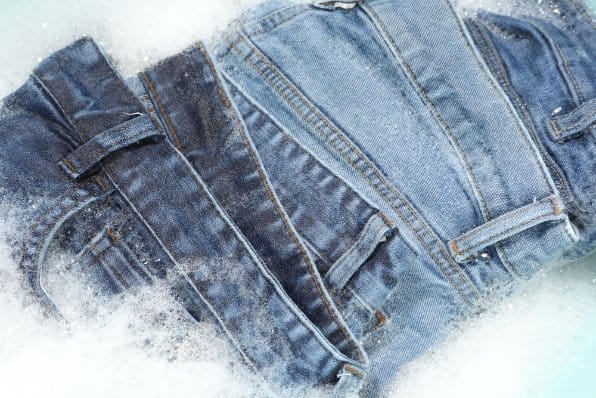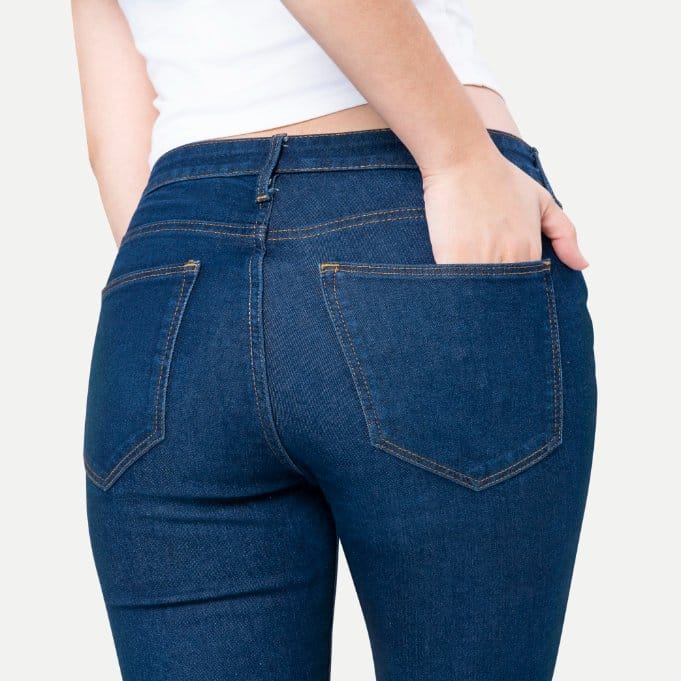Expert Tips to Extend Jean Life and Preserve Quality
Your favorite jeans deserve proper care to maintain their fit, comfort, and appearance. Those perfectly worn-in pairs that feel like a second skin need special attention to stay in great shape for years to come. Washing your jeans every 10 wears helps maintain their fit while preventing excessive wear and tear.
Taking care of denim doesn’t need to be complicated. Simple steps like spot cleaning stains and turning jeans inside out before washing can make a big difference. Proper denim care helps preserve the unique fading patterns and character that make your jeans distinctly yours.
Table of Contents
Key Takeaways
- Wash jeans sparingly and spot clean when possible to maintain their shape and color
- Turn jeans inside out and use cold water to protect the fabric during washing
- Air dry your denim to prevent shrinkage and preserve the fit
- Different denim types require specific care approaches
- Sustainable care practices extend jean life while reducing environmental impact
- Take our denim care quiz to discover your specific jean type and get personalized recommendations
- Use our wash frequency calculator to determine optimal washing schedules
Understanding Denim: The Foundation of Proper Care
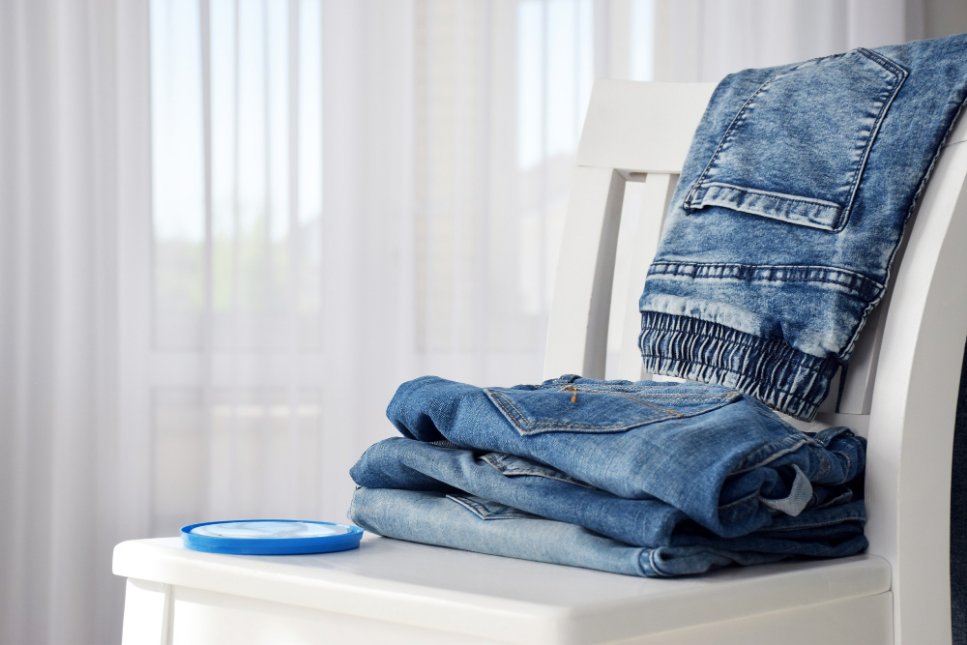
Proper denim care starts with understanding what makes this fabric special. Denim is a sturdy cotton twill fabric made from tightly woven threads. The unique weaving pattern creates the distinctive diagonal ribbing that gives denim its strength and durability.
Raw denim starts stiff but softens with wear and develops unique fade patterns. The indigo dye used in most jeans naturally fades over time, creating personalized wear patterns that tell your story. Your jeans contain natural oils that help maintain their shape and appearance. These oils stay in the fabric when you limit washing.
According to Levi’s official denim care guide, washing your jeans sparingly is the most important rule for maintaining their quality. The denim experts at Levi’s, with over 150 years of experience, recommend washing jeans after about 10 wears unless they’re visibly dirty or smell.
Different Types of Denim and Their Care Needs
- Raw Denim: Unwashed and untreated, requiring the gentlest care. Wait at least 6 months before the first wash to develop natural fading patterns.
- Stretch Denim: Contains elastane or spandex (typically 1-5%), requiring special care to preserve elasticity. Use cold water and avoid fabric softeners that can break down the stretch fibers.
- Pre-washed Denim: Already treated and processed, can handle more frequent washing but still benefits from gentle care.
- Premium Denim: High-quality fabrics often with special treatments, requiring careful attention to preserve their unique characteristics.
When to Wash Your Denim: The 10-Wear Rule and Beyond
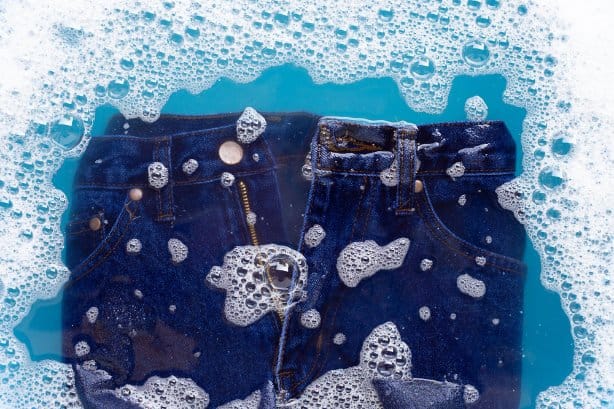
How to Properly Take Care of Denim
The foundation of denim care is knowing when to wash. Wait about 10 wears between washes to preserve the natural wear patterns and unique character of your jeans. This rule applies to most pre-washed denim, but different types have different needs:
- Raw denim: Wait 6+ months or 180+ wears for first wash
- Stretch denim: Every 8-10 wears due to body oils affecting elasticity
- Premium denim: Follow manufacturer guidelines, typically 10-15 wears
- Work jeans: More frequent washing may be needed based on activity level
Understanding when to wash different types of denim can be confusing. This simple guide breaks down the washing frequency for each denim type:
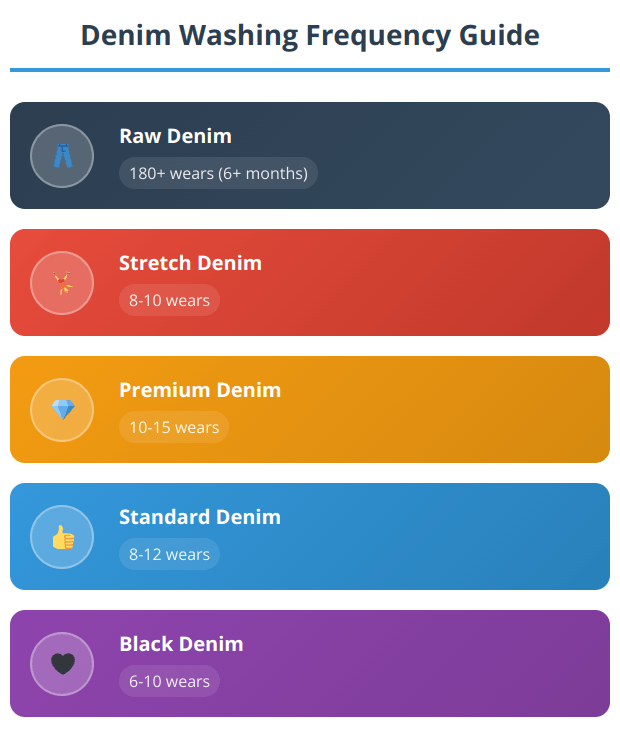
Remember, these are guidelines. Always prioritize washing when jeans become visibly dirty or develop odors, regardless of wear count.
Are You Supposed to Wash Denim After Every Wear?
No, washing denim after every wear is unnecessary and harmful. Only wash your jeans when they:
- Develop noticeable odors
- Show visible dirt or stains
- Feel uncomfortable due to stretching
- Have been worn in particularly sweaty conditions
Between washes, hang your jeans to air out and spot clean any small stains with a damp cloth.
Not sure how often to wash your specific jeans? Our care schedule calculator takes into account your activity level, jean type, and lifestyle to give you a personalized washing timeline.
The Science of Denim Washing: Temperature and Technique
Is It Better to Wash Jeans at 30 or 40 Degrees?
30°C (86°F) is the ideal temperature for washing jeans. This temperature effectively cleans while minimizing shrinkage and color loss.
Temperature makes a significant difference in denim care outcomes. Here’s what happens at different washing temperatures:
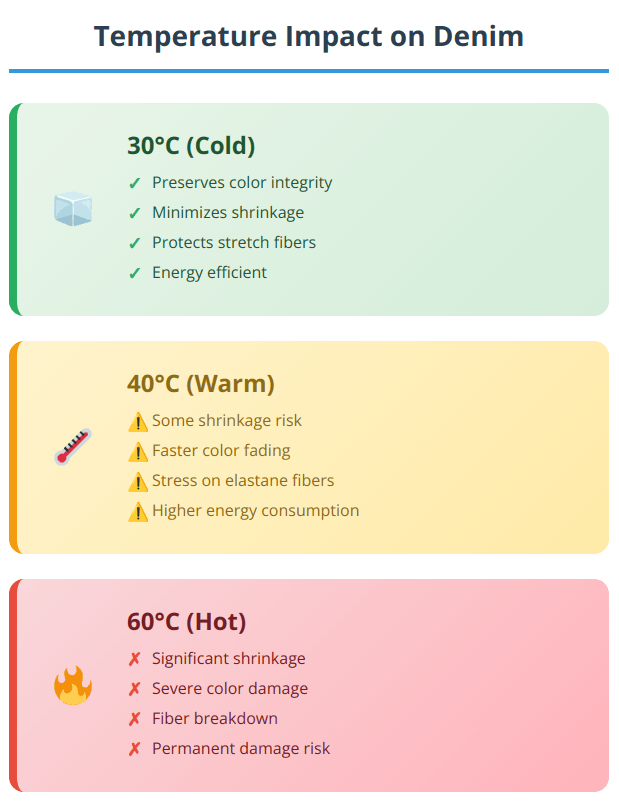
Stick to 30°C or below for all your denim washing needs. The small temperature difference makes a huge impact on jean longevity.
Here’s why temperature matters:
30°C Benefits:
- Preserves color and prevents fading
- Minimizes shrinkage
- Protects stretch fibers in blended denim
- Energy efficient
40°C Risks:
- Increased shrinkage potential
- Faster color bleeding
- Can damage elastane fibers
- Higher energy consumption
Will 60 Degrees Shrink Jeans?
Yes, washing at 60°C (140°F) will definitely shrink your jeans and should be avoided. High temperatures cause cotton fibers to contract significantly and can damage any stretch components in the fabric.
Is 30 Degrees a Cold Wash?
Yes, 30°C is considered a cold wash in most washing machines. This temperature provides the perfect balance between cleaning effectiveness and fabric protection for denim care.
Machine Washing vs Hand Washing: What’s Best for Your Jeans?
Can I Put Denim Jeans in the Washing Machine?
Yes, you can safely machine wash most denim jeans with proper technique. Modern washing machines are gentler than ever, making machine washing practical for busy lifestyles.
Machine Washing Best Practices:
- Turn jeans inside out before washing
- Use the gentle or delicate cycle
- Wash in cold water (30°C max)
- Zip all zippers and fasten buttons
- Wash denim separately from other clothes
Choosing between machine and hand washing depends on your denim type and personal preferences. Here’s how they compare:
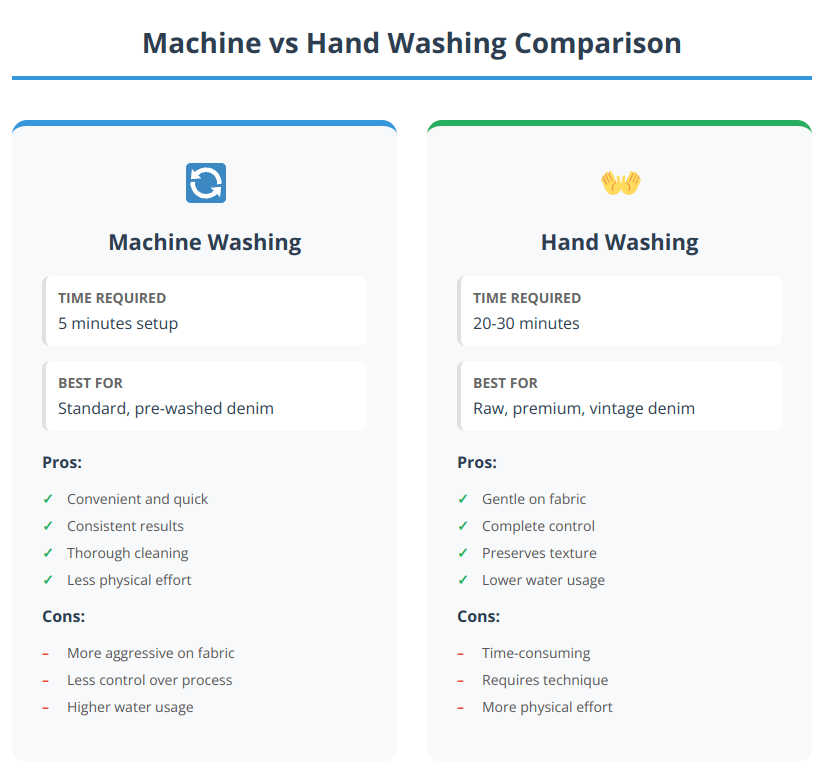
Both methods work well when done correctly. Choose based on your denim type, available time, and personal comfort level.
Hand Washing for Premium Care
Hand washing provides the gentlest care, especially for raw denim or premium pieces. This method gives you complete control over the process and minimizes stress on the fabric.
When to hand wash:
- Raw denim (especially first wash)
- Premium or designer jeans
- Vintage denim pieces
- Stretch denim that needs extra care
- When you want maximum color preservation
Step-by-step hand washing process:
- Fill a large sink or bathtub with cold water
- Add a small amount of mild detergent
- Submerge jeans and gently agitate for 5-10 minutes
- Rinse thoroughly with cold water
- Gently squeeze out excess water (never wring)
For a visual demonstration of proper hand washing technique, this video shows you exactly how to wash your jeans by hand safely:
Pro tip: After hand washing, lay your jeans flat on a clean towel and roll them up to remove excess water before hanging to dry. This prevents stretching and maintains the proper shape.
Raw Denim: Special Care for Special Jeans
Are You Supposed to Wash Raw Denim?
Raw denim requires a completely different approach. Don’t wash raw denim for at least 6 months to develop proper fade patterns. This waiting period allows the denim to:
- Mold to your body shape
- Develop natural creases and whiskers
- Create unique fade patterns
- Maintain stiffness that gradually softens
Does Unwashed Denim Shrink?
Raw denim will shrink significantly on first wash, typically 1-2 inches in length and waist. This is normal and expected. Many raw denim enthusiasts buy jeans slightly larger to accommodate this shrinkage.
Will Raw Denim Still Fade After Washing?
Yes, raw denim continues to fade after washing, but the process slows down. The first wash sets the major fade patterns, while continued wear and subsequent washes create more subtle evolution in color and contrast.
Choosing the Right Products for Denim Care
What Is the Best Detergent for Denim?
Choose a mild detergent specifically designed for dark clothes or denim. The best options include:
Recommended Types:
- Denim-specific detergents (Woolite Darks, etc.)
- Color-protecting formulas
- Gentle, pH-balanced detergents
- Liquid detergents over powder
Products to Avoid:
- Bleach or whitening agents
- Fabric softeners (break down fibers)
- Harsh detergents with optical brighteners
- Stain removers with bleaching compounds
Use only half the recommended amount of detergent to prevent residue buildup that can affect texture and appearance.
The right products can make or break your denim care routine. Here’s your complete product selection guide:
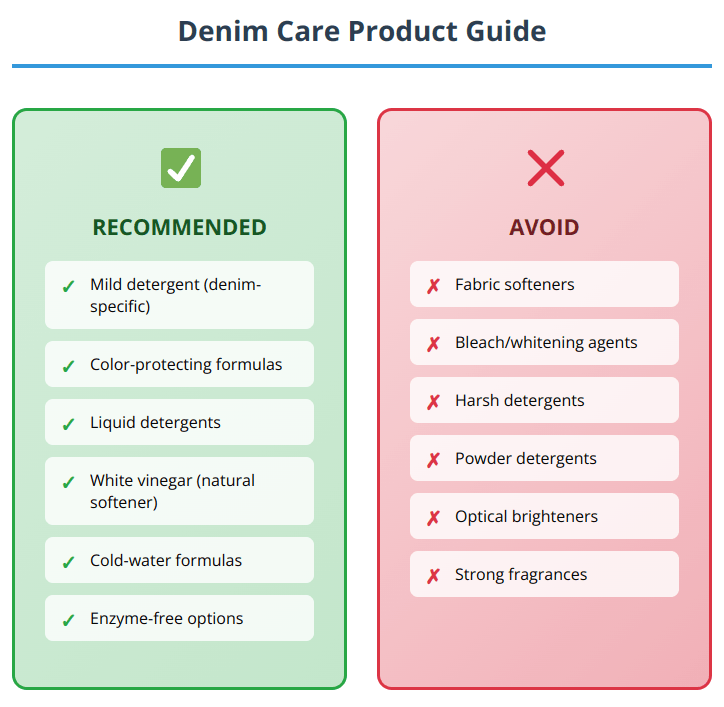
Remember to use only half the recommended detergent amount to prevent residue buildup that can affect your jeans’ texture
Proper Drying Techniques for Denim Longevity
Air drying is crucial for maintaining your jeans’ shape, color, and fit. Machine drying can cause irreversible damage through heat and tumbling action.
Air-Drying Best Practices
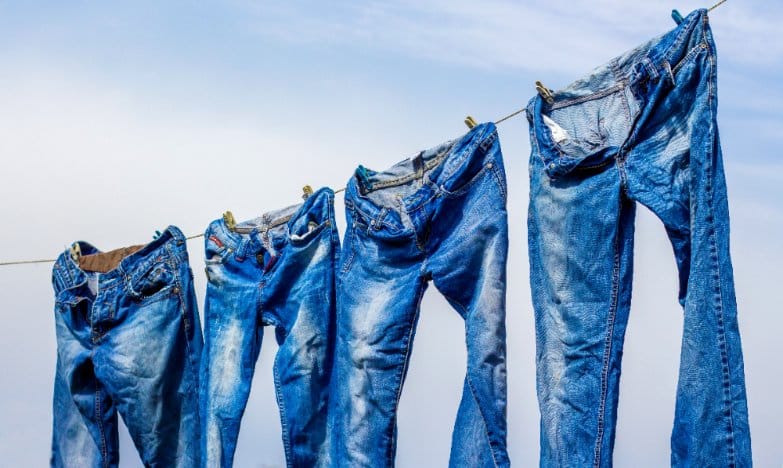
Hanging Method:
- Hang jeans by the waistband using sturdy clips
- Smooth out wrinkles and align seams
- Choose a well-ventilated area away from direct sunlight
- Allow 12-24 hours for complete drying
Flat Drying Alternative:
- Lay jeans flat on a clean towel
- Reshape while damp to maintain fit
- Flip halfway through drying process
- Good for heavy or delicate denim
Can Primark Jeans Be Tumble Dried?
While budget jeans like Primark’s may seem less precious, they still benefit from air drying. If you must use a dryer, use the lowest heat setting and remove while slightly damp to finish air drying.
Regional Washing Differences: US vs UK Approaches
How to Wash Jeans in the US
American washing machines typically use more water and have different cycle options:
- Use “cold” water setting (typically 60-80°F)
- Select “delicate” or “hand wash” cycle
- Use liquid detergent designed for cold water
- Consider high-efficiency (HE) detergent if you have an HE machine
How to Wash Jeans in the UK
UK washing machines often have more precise temperature controls:
- Set to 30°C for optimal results
- Use “synthetic” or “delicate” cycle
- European detergents are often more concentrated
- Consider eco-friendly cycles for environmental benefits
Washing machine differences between regions affect your denim care approach. Here’s how to adapt your technique:
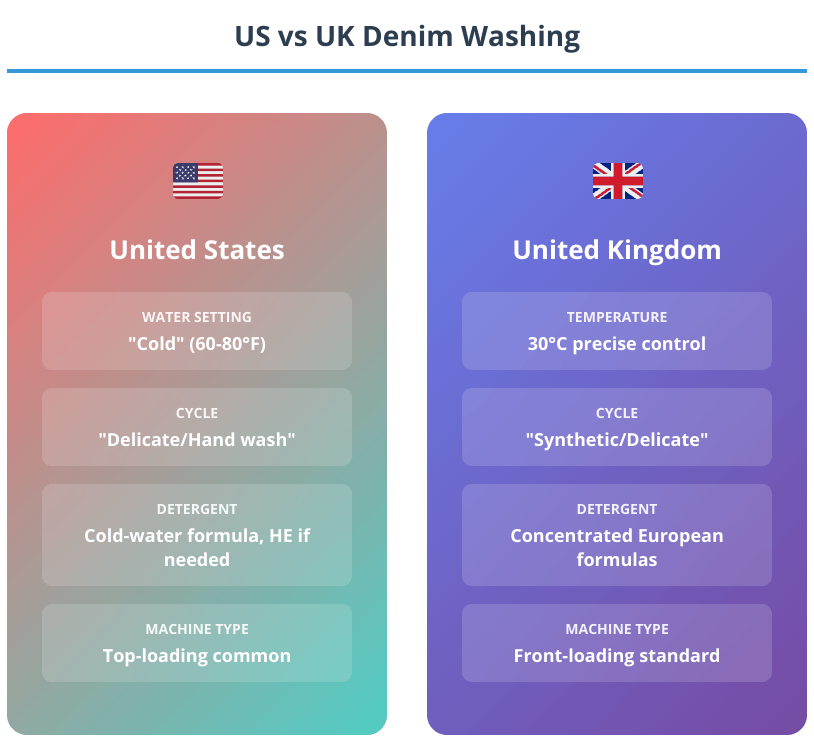
Regardless of your location, the principles remain the same: cold water, gentle cycles, and mild detergents for best results.
Solving Common Denim Problems
How to Stop Jeans from Smelling
Prevention:
- Hang jeans to air out after each wear
- Store in well-ventilated areas
- Rotate between multiple pairs
Treatment:
- Spot clean problem areas
- Steam in bathroom while showering
- Freeze overnight to kill bacteria
- Use fabric refresher spray designed for denim
Every denim lover faces these common issues. Here are quick solutions for the most frequent problems:
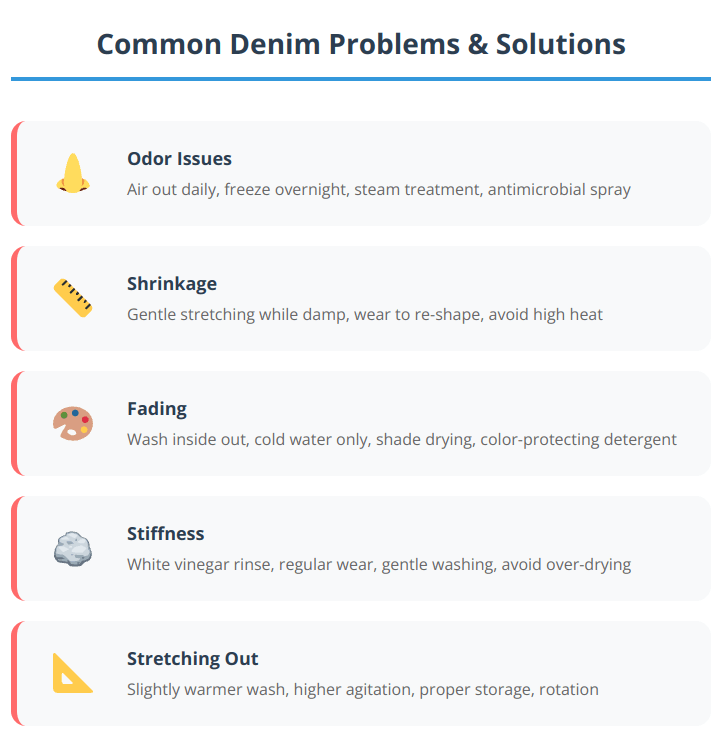
Prevention is always better than correction. Following proper care techniques helps avoid most of these issues entirely.
Do Levi’s Get Tighter After Washing?
Yes, Levi’s and most cotton denim will shrink slightly after washing, making them feel tighter. This is normal, especially for 100% cotton styles like the 501s. The jeans will gradually stretch back to a comfortable fit with wear.
How to Soften Jeans Permanently
Natural Methods:
- Wash with white vinegar (1/2 cup in rinse cycle)
- Use tennis balls in dryer on air-dry setting
- Wear regularly to break in naturally
- Hand wash with gentle agitation
Avoid fabric softeners as they can break down denim fibers and affect the fabric’s integrity over time.
Color Care and Bleeding Prevention
How to Wash Black Jeans for the First Time
Black jeans require extra care to prevent fading:
- Turn inside out before washing
- Wash alone or with other dark items
- Use cold water (30°C max)
- Choose detergent for dark colors
- Add 1/2 cup white vinegar to help set dye
- Air dry away from direct sunlight
How Many Washes Until Jeans Stop Bleeding?
Most jeans stop significant color bleeding after 3-5 washes. Premium denim with higher-quality dyes may bleed less, while budget jeans might continue bleeding for more washes. Always wash new dark jeans separately for the first few washes.
Technical Washing Settings and Considerations
What Spin Cycle Should I Use for Jeans?
Use a low to medium spin cycle (800-1000 RPM) for jeans. High spin speeds can:
- Cause excessive wrinkling
- Stress seams and hardware
- Create permanent creases
- Damage stretch fibers
Getting your washing machine settings right is crucial for denim care. Here’s your complete settings checklist:
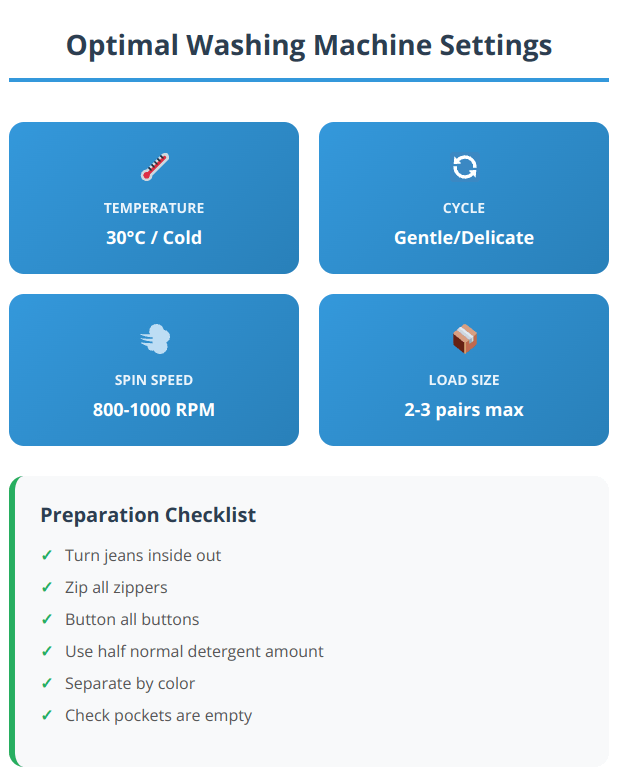
These settings work for most washing machines. Check your manual for equivalent settings if your machine uses different terminology.
Should You Wash Jeans Zipped or Unzipped?
Always zip zippers and fasten all buttons before washing. This helps:
- Maintain the jeans’ shape
- Prevent snagging other items
- Reduce stress on hardware
- Keep pockets from turning inside out
Can I Wash Jeans with Towels?
It’s better to wash jeans separately or with similar-weight items. Towels can be too abrasive and may cause:
- Excessive friction leading to wear
- Lint transfer to jeans
- Uneven washing due to different absorption rates
Can You Wash Jeans with Socks?
Yes, you can wash jeans with socks and other small items, but ensure:
- All items are similar colors
- Nothing has rough textures
- You’re not overloading the machine
- Water temperature suits all items
Sizing and Fit Considerations
What Size 501 Jeans Should I Buy?
Levi’s 501s are known to shrink, so:
- Buy true to size if you plan to wash regularly
- Size up 1-2 inches in waist if buying raw
- Consider inseam shrinkage (1-2 inches typical)
- Try on after the first wash for best fit assessment
Can I Unshrink Jeans?
Partially, yes. While you can’t completely reverse shrinkage:
Gentle Stretching Method:
- Dampen jeans with cold water
- Gently stretch while damp
- Wear while slightly damp to stretch naturally
- Focus on problem areas (waist, length)
Professional alterations may be needed for significant size adjustments.
Sustainable Denim Care Practices
Reducing Environmental Impact
The environmental impact of denim production is substantial. Research highlighted by National Geographic shows that dyeing just one pair of jeans can require nearly 30 gallons of water, and the chemical additives used are highly alkaline and corrosive. This is why proper care that extends jean life is crucial for reducing environmental impact.
Sustainable denim care benefits both your jeans and the planet:
Water Conservation:
- Wash less frequently (every 10+ wears)
- Use cold water to save energy
- Spot clean instead of full washing
- Consider hand washing for delicate pieces
Energy Savings:
- Air dry instead of machine drying
- Use eco-friendly detergents
- Wash full loads when possible
- Choose energy-efficient wash cycles
Longevity Focus:
- Repair small tears quickly
- Rotate between multiple pairs
- Store properly to maintain shape
- Invest in quality denim that lasts longer
Eco-Friendly Product Choices
- Biodegradable detergents
- Concentrated formulas (less packaging)
- Refillable containers
- Plant-based stain removers
Sustainable denim care benefits both your jeans and the planet. Here’s how your care choices impact the environment:
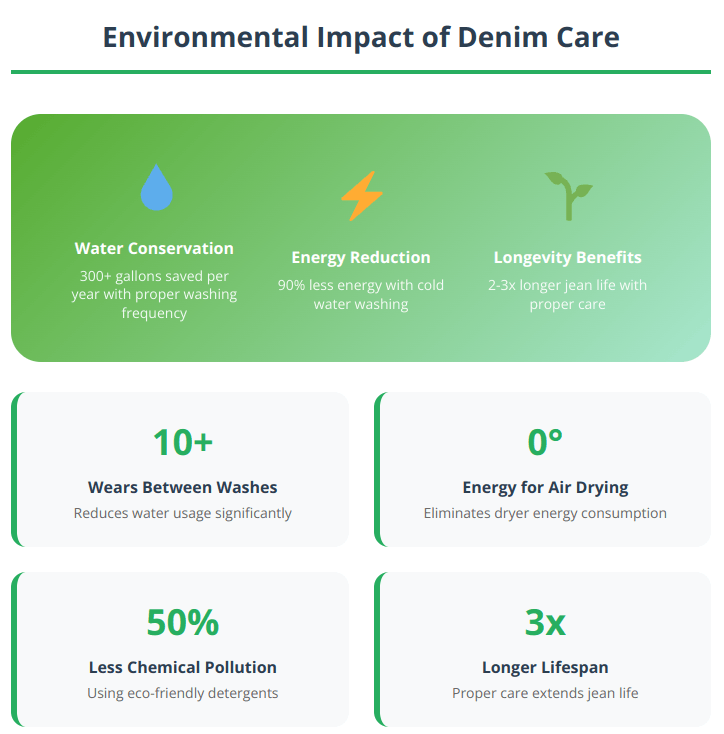
Small changes in your denim care routine can significantly reduce your environmental footprint while saving money.
Want to see the real impact of your denim care habits? Try our environmental impact tracker to visualize your water and energy savings with better care practices.
Advanced Denim Care Techniques
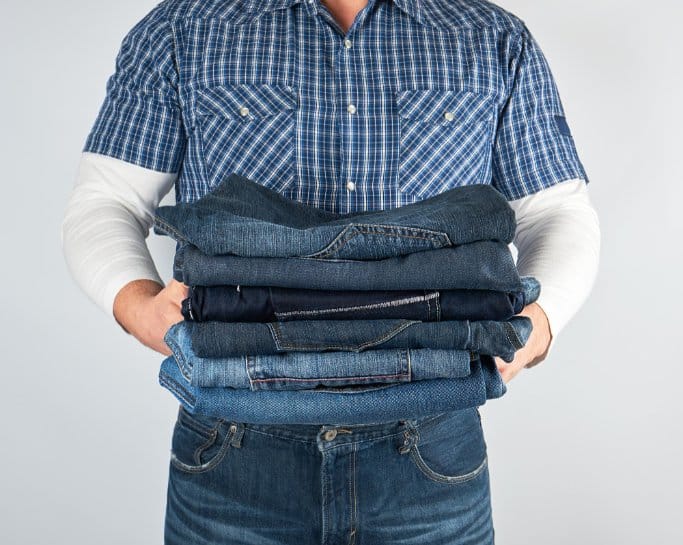
Storage Solutions for Optimal Preservation
Folding Method:
- Fold along natural creases
- Store flat in drawers
- Don’t over-stack to prevent creasing
- Use tissue paper for premium denim
Hanging Method:
- Use padded hangers for heavy denim
- Clip hangers work well for waistbands
- Ensure adequate space between garments
- Avoid wire hangers that can create marks
Long-term Storage:
- Clean before storing
- Ensure complete dryness
- Use breathable cotton garment bags
- Add cedar blocks for freshness
- Avoid plastic bags that trap moisture
Professional Care Considerations
When to Consider Dry Cleaning:
- Expensive designer denim with special treatments
- Heavily structured denim jackets
- Vintage pieces requiring gentle care
- Items with non-denim components (leather trim, etc.)
Working with Tailors:
- Find professionals experienced with denim
- Discuss shrinkage potential before alterations
- Consider chain-stitching for authentic hems
- Ask about repair services for tears or wear
Take your denim care to the next level with these advanced techniques used by denim enthusiasts and professionals:
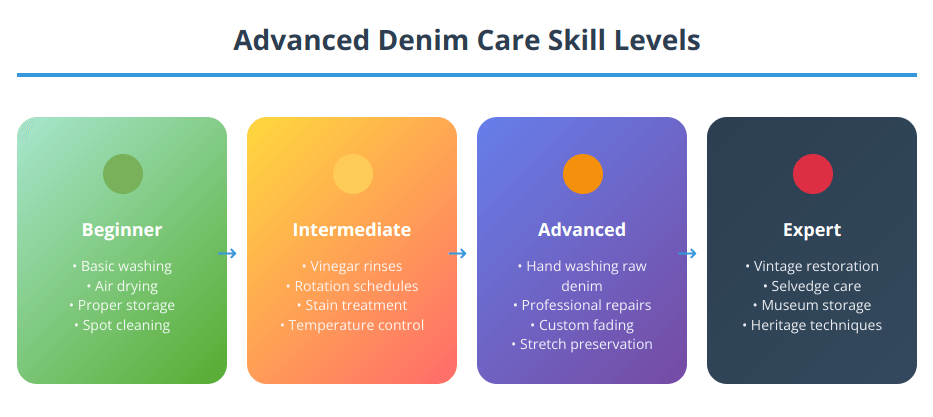
Master the basics before moving to advanced techniques. Each skill level builds on the previous one for optimal results.
Troubleshooting Common Issues
Dealing with Stubborn Stains
Oil-based stains:
- Blot immediately, don’t rub
- Apply cornstarch to absorb oil
- Let sit for 30 minutes
- Brush off and spot clean with dish soap
- Wash as normal
Protein stains (blood, sweat):
- Rinse with cold water immediately
- Pre-treat with enzyme detergent
- Soak for 30 minutes before washing
- Never use hot water (sets protein stains)
Addressing Fit Issues
Jeans Too Tight After Washing:
- Wear while slightly damp to stretch
- Do gentle stretches and squats
- Focus on problem areas with targeted stretching
- Be patient; denim gradually relaxes with wear
Jeans Too Loose:
- Try a slightly warmer wash (35°C)
- Use higher agitation setting
- Consider professional tailoring
- Check if exchange is possible
When denim care goes wrong, quick action can often save the day. Here’s your emergency troubleshooting guide:
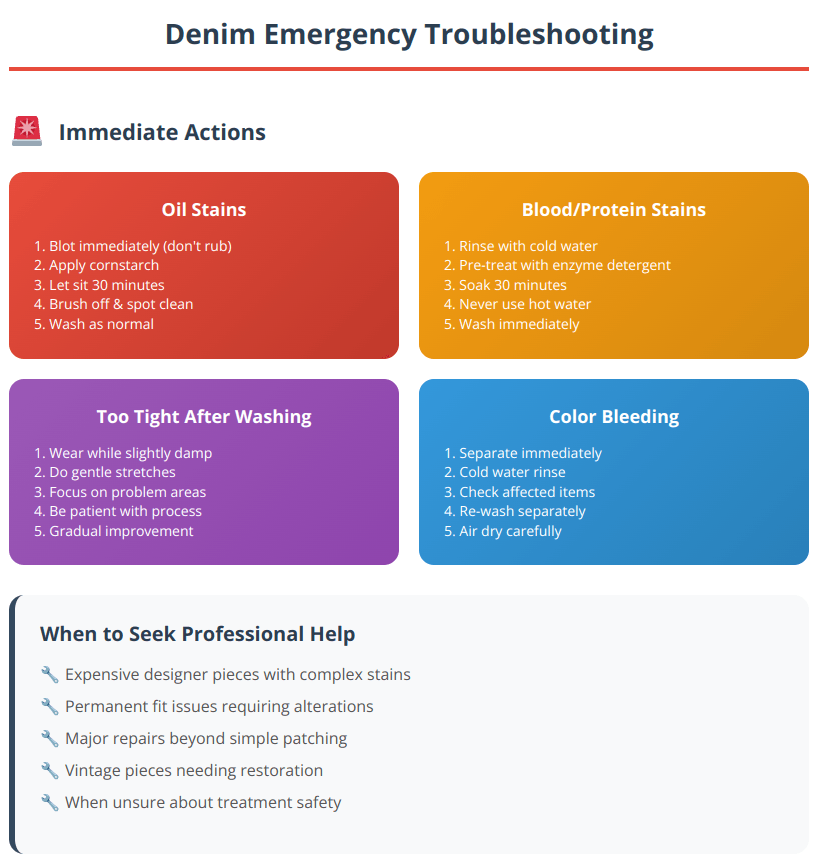
Quick response to problems often prevents permanent damage. When in doubt, consult a professional rather than risking your favorite jeans.
Dealing with a specific denim problem? Use our interactive troubleshooting flowchart to get step-by-step solutions for shrinkage, fading, stains, and other common issues.
Special Considerations by Activity Level
Office Workers vs. Active Lifestyles
Desk Job Denim Care:
- Can extend wear between washes (12-15 wears)
- Focus on odor prevention rather than dirt removal
- Spot clean food stains promptly
- Hang to air out daily
Active Lifestyle Adjustments:
- Wash more frequently (5-8 wears)
- Pre-treat sweat stains immediately
- Consider moisture-wicking denim blends
- Have backup pairs for rotation
Building a Sustainable Denim Wardrobe
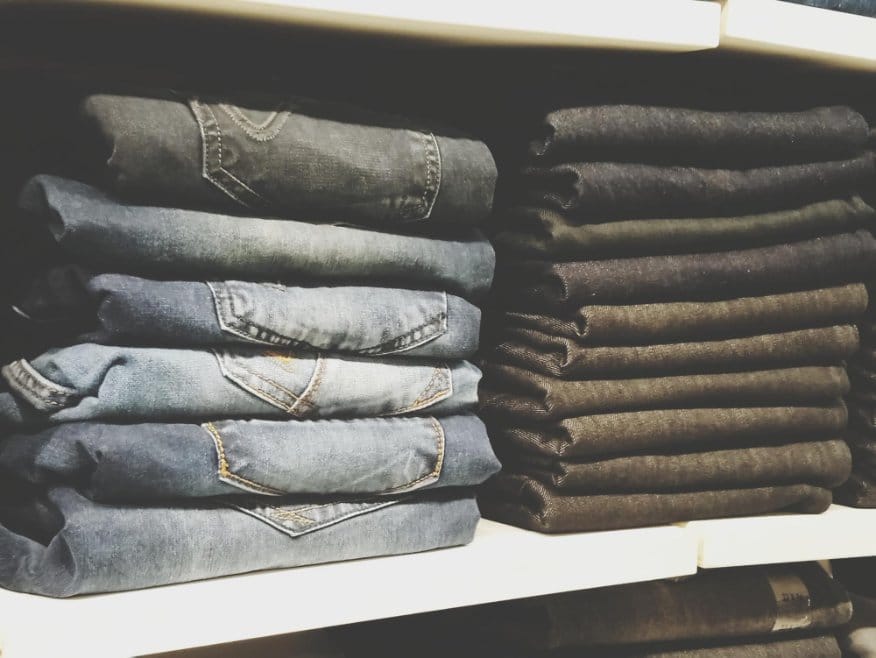
How Many Jeans Should I Own?
Minimalist approach: 3-4 pairs
- One dark wash for dressier occasions
- One medium wash for everyday wear
- One light wash for casual/weekend
- One backup pair
Practical wardrobe: 5-7 pairs
- Multiple fits (skinny, straight, wide)
- Various washes and styles
- Seasonal considerations
- Specialty pairs (raw denim, premium brands)
A well-planned denim wardrobe reduces waste and ensures you always have the right pair. Here’s how to build yours sustainably:
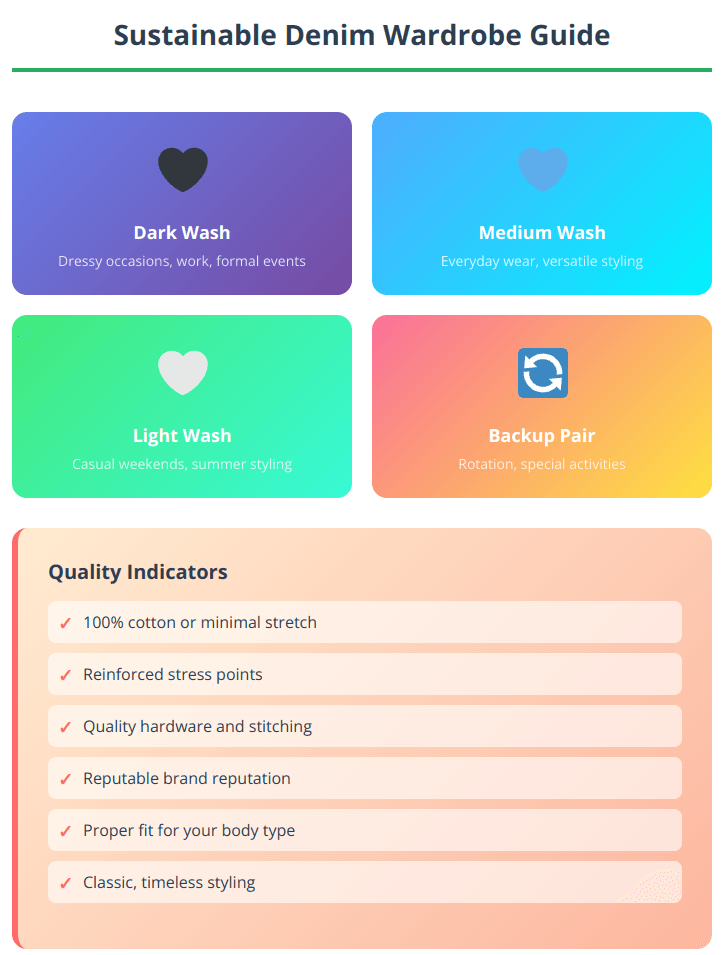
Quality over quantity is key. Invest in fewer, better pieces that will serve you well for years rather than cheap jeans that need frequent replacement.
Can I Wear Jeans Twice Without Washing?
Absolutely! In fact, you should wear jeans multiple times before washing. Most denim enthusiasts wear jeans 8-15 times between washes, depending on:
- Activity level during wear
- Climate conditions
- Personal comfort preferences
- Denim type and quality
Regional and Cultural Variations
International Denim Care Practices
Japanese Approach:
- Minimal washing philosophy
- Hand washing preferred
- Line drying standard
- Focus on natural fade development
European Standards:
- 30°C washing temperature norm
- Eco-friendly detergents preferred
- Energy-efficient practices emphasized
- Quality over quantity mindset
American Trends:
- Convenience-focused methods
- Machine washing accepted
- Quick-dry expectations
- Variety in care approaches
The Economics of Proper Denim Care
How Long Should a Pair of Jeans Last?
With proper care, quality jeans should last:
- Premium denim: 10-20 years with regular wear
- Mid-range jeans: 3-7 years
- Budget jeans: 1-3 years
- Raw denim: 15+ years with proper breaking in
Cost-Benefit Analysis
Investment in Care:
- Quality detergent: $0.10-0.20 per wash
- Air drying: No additional cost
- Proper storage: One-time investment
- Repairs: $10-50 vs. $50-200 replacement
Long-term Savings:
- Extend jean life by 2-3x with proper care
- Reduce replacement frequency
- Maintain resale value for premium pieces
- Environmental cost savings
Proper denim care is an investment that pays dividends. Here’s the financial impact of good versus poor care habits:

The small investment in proper care products and techniques pays for itself many times over in extended jean life and reduced replacement costs.
Calculate exactly how much money proper denim care can save you with our cost savings calculator. See the financial impact of extending jean life through better maintenance.
Seasonal Denim Care Adjustments
Summer Care Considerations
Increased Washing Frequency:
- Hot weather means more sweat
- Wash every 6-8 wears instead of 10
- Focus on odor prevention
- Use antimicrobial sprays between wears
Drying Challenges:
- High humidity slows air drying
- Avoid direct sunlight fading
- Use fans to improve air circulation
- Consider dehumidifiers in damp climates
Winter Storage and Care
Reduced Washing Needs:
- Cold weather means less sweating
- Can extend wear between washes
- Focus on proper storage in heated homes
- Prevent moth damage with cedar
Heating Considerations:
- Avoid drying near direct heat sources
- Radiator drying can cause uneven shrinkage
- Maintain humidity levels to prevent cracking
- Store away from heat vents
Your denim care routine should adapt to seasonal changes. Here’s how weather affects your approach:

Adapting your care routine to seasonal changes helps maintain optimal denim condition year-round while responding to climate challenges.
Unique Care Questions Answered
Why Keep Jeans in the Oven?
Some people put jeans in a warm (not hot) oven to:
- Kill bacteria without washing
- Slightly reshape after stretching
- Remove odors naturally
Safety Note: Only use very low temperatures (under 200°F) and never leave unattended. This method is not recommended for synthetic blends or stretch denim.
Should Jeans Be Ironed?
Generally, jeans don’t need ironing if properly hung to dry. If you must iron:
- Turn inside out
- Use medium heat
- Iron along seams to maintain structure
- Avoid ironing over hardware
- Consider steaming instead for wrinkle removal
What Happens If You Wash Jeans at 40 Degrees?
Washing at 40°C (104°F) can cause:
- Noticeable shrinkage (1-2 sizes)
- Faster color fading
- Stress on stretch fibers
- Potential damage to special treatments
- Increased energy consumption
Creating Your Personal Denim Care Routine
Weekly Maintenance Schedule
Daily (After Wear):
- Hang jeans to air out
- Check for stains or damage
- Rotate pairs to prevent over-wear
Weekly:
- Assess which pairs need washing
- Spot clean minor stains
- Check storage areas for proper ventilation
Monthly:
- Deep clean storage areas
- Assess overall wardrobe condition
- Plan seasonal transitions
Building Sustainable Habits
Start Small:
- Focus on one good habit (air drying)
- Gradually extend time between washes
- Invest in quality hangers and storage
Track Your Success:
- Note wash frequency and results
- Document which methods work best
- Adjust routine based on lifestyle changes
Developing a personal denim care routine ensures consistency and optimal results. Here’s how to create yours:
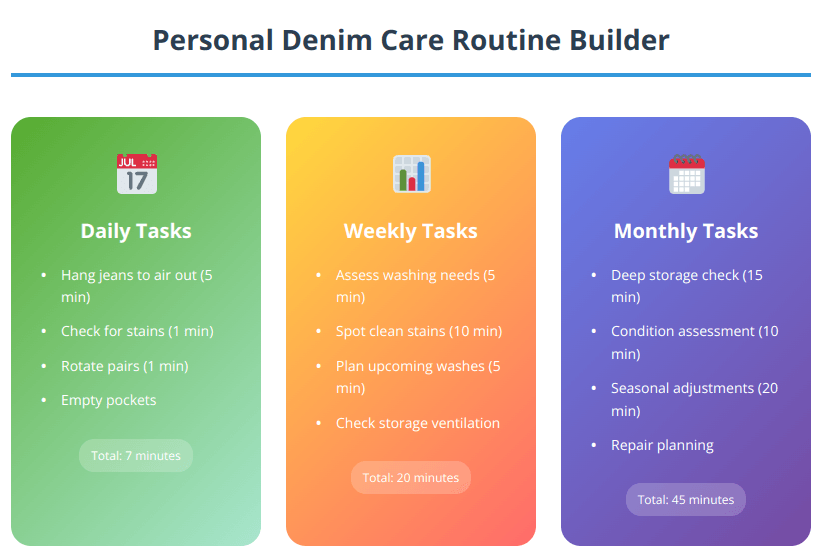
Start with daily habits, then build weekly and monthly routines. Consistency in small actions leads to dramatically better long-term results.
Not sure where to start? Take our quick denim care quiz to identify your jean type and get a customized care routine that fits your lifestyle.
Emergency Denim Care
Quick Fixes for Common Problems
Unexpected Odor:
- Fabric refresher spray
- Steam in bathroom
- Brief outdoor airing
- Dryer sheets in pockets (remove before wearing)
Last-Minute Stains:
- Blot, don’t rub
- Cold water for most stains
- Hand soap for oil stains
- Accept that some stains need time to treat properly
Urgent Wrinkle Removal:
- Hang in steamy bathroom
- Use wrinkle-release spray
- Spot iron inside-out
- Embrace the rumpled denim look
Sometimes you need immediate denim solutions. Here’s your quick-fix guide for common emergencies:
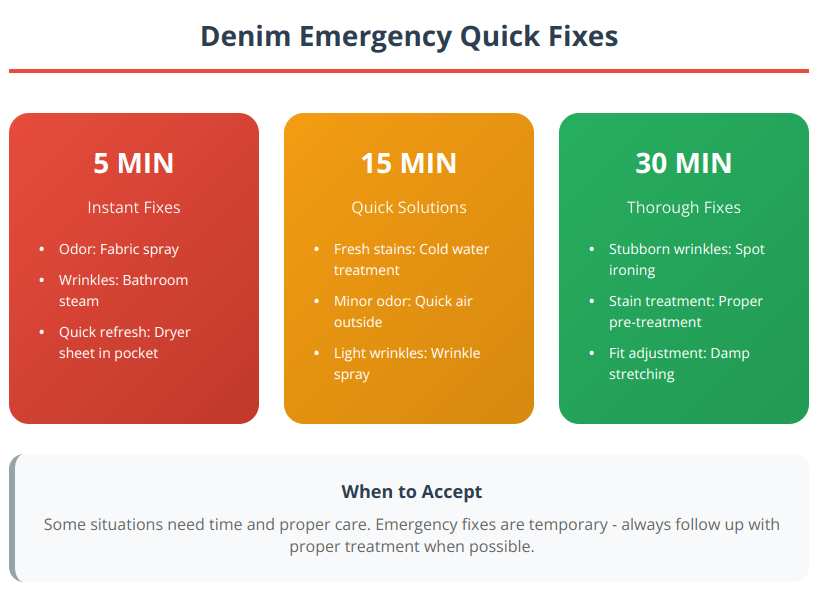
Emergency fixes are temporary solutions. Always follow up with proper care when time allows for best long-term results
Technology and Denim Care
Modern Washing Machine Features
Denim-Specific Cycles:
- Many new machines have denim settings
- Adjusts water temperature and agitation
- Optimizes spin speed for heavy fabrics
- Reduces washing time for gentler care
Smart Washing Features:
- Load sensing prevents overloading
- Automatic detergent dispensing
- Energy monitoring for eco-friendly washing
- App connectivity for remote monitoring
Future of Denim Care
Emerging Technologies:
- Antimicrobial treatments reducing wash frequency
- Improved stretch recovery in fabrics
- Eco-friendly dyeing processes
- Smart fabrics that indicate when washing is needed
Modern technology is revolutionizing denim care. Here’s how to leverage new innovations for better results:
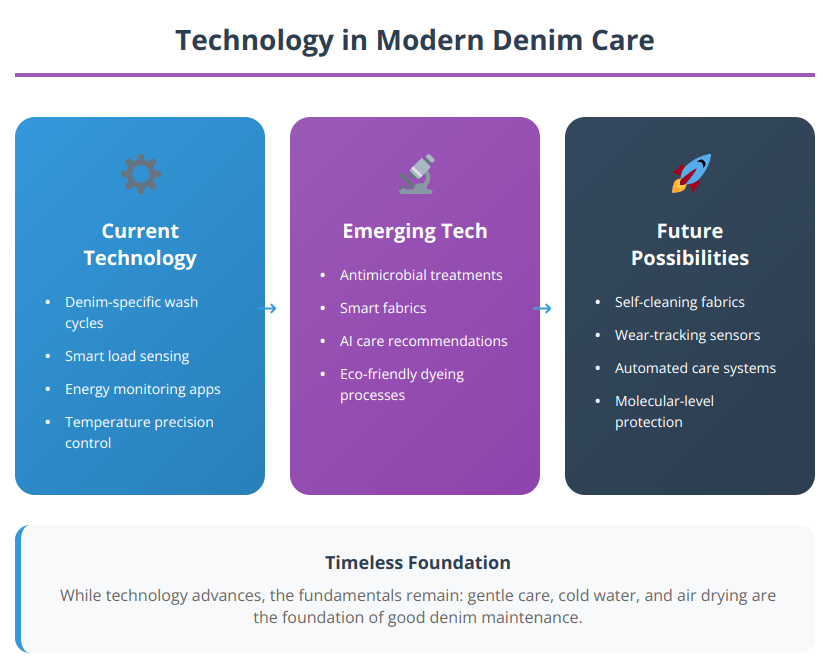
While technology advances, the fundamental principles of gentle care, cold water, and air drying remain the foundation of good denim maintenance.
Comprehensive FAQ Section
Frequency and Timing Questions
Can I wear jeans twice without washing?
Yes, you should wear jeans multiple times before washing. Most denim can be worn 8-15 times between washes, depending on activity level and personal comfort.
Are you supposed to wash denim after every wear?
No, washing after every wear is unnecessary and harmful to denim. Only wash when jeans smell, show visible dirt, or feel uncomfortable.
Technical Care Questions
What spin cycle should I use for jeans?
Use a low to medium spin cycle (800-1000 RPM) to prevent excessive wrinkling and stress on seams.
Should you wash jeans zipped or unzipped?
Always zip zippers and fasten buttons before washing to maintain shape and prevent hardware damage.
Is 30 degrees a cold wash?
Yes, 30°C is considered a cold wash and is ideal for denim care, providing effective cleaning while minimizing shrinkage and color loss.
Compatibility Questions
Can I wash jeans with towels?
It’s better to wash jeans separately. Towels can be too abrasive and may cause friction damage to denim.
Can you wash jeans with socks?
Yes, you can wash jeans with socks and similar small items, provided they’re similar colors and you don’t overload the machine.
Product and Treatment Questions
What is the best detergent for denim?
Use mild detergents designed for dark colors or denim-specific formulas. Avoid bleach, fabric softeners, and harsh chemicals.
How to soften jeans permanently?
Use white vinegar in the rinse cycle, wear regularly to break in naturally, or try gentle hand washing. Avoid fabric softeners that can damage fibers.
Specific Brand and Style Questions
Do Levi’s get tighter after washing?
Yes, Levi’s and most cotton denim will shrink slightly after washing. They’ll gradually stretch back to comfortable fit with wear.
What size 501 jeans should I buy?
Buy true to size for regular washing, or size up 1-2 inches if buying raw denim that will shrink significantly.
Problem-Solving Questions
Can I unshrink jeans?
Partially. You can gently stretch damp jeans and wear them while slightly damp to help restore some size, but complete reversal isn’t possible.
How to stop jeans from smelling?
Hang to air out after wear, store in ventilated areas, steam in bathroom, or freeze overnight to kill bacteria. Spot clean as needed.
Should jeans be ironed?
Generally no. Proper air drying should prevent wrinkles. If needed, iron inside-out on medium heat, avoiding hardware.
Safety and Temperature Questions
Will 60 degrees shrink jeans?
Yes, 60°C will definitely shrink jeans significantly and should be avoided. Stick to 30°C maximum for safe washing.
What happens if you wash jeans at 40 degrees?
Washing at 40°C can cause noticeable shrinkage, faster fading, and potential damage to stretch fibers.
Raw Denim Specific Questions
Are you supposed to wash raw denim?
Wait at least 6 months before washing raw denim to develop proper fade patterns and break-in characteristics.
Does unwashed denim shrink?
Raw denim will shrink significantly (1-2 inches) on first wash. This is normal and expected.
Will raw denim still fade after washing?
Yes, raw denim continues to fade after washing, though the process slows down considerably.
Think you know everything about denim care? Test your knowledge and learn the truth with our denim myths debunked guide that separates fact from fiction.
Quick Reference Care Chart
| Denim Type | Wash Frequency | Water Temp | Special Notes |
|---|---|---|---|
| Raw Denim | 6+ months | Cold (30°C) | Hand wash preferred |
| Stretch Denim | 8-10 wears | Cold (30°C) | No fabric softener |
| Premium Denim | 10-15 wears | Cold (30°C) | Follow brand guidelines |
| Standard Denim | 8-12 wears | Cold (30°C) | Turn inside out |
| Black Denim | 6-10 wears | Cold (30°C) | Wash separately first few times |
Denim Care Decision Flowchart
Is your denim visibly dirty or smelly?
├─ Yes → Wash following appropriate method
└─ No → Can you spot clean the issue?
├─ Yes → Spot clean and air out
└─ No → How many wears since last wash?
├─ Under 8 wears → Continue wearing, air out daily
└─ Over 10 wears → Consider washing soon
When in doubt about whether to wash your jeans, use this simple decision-making flowchart:
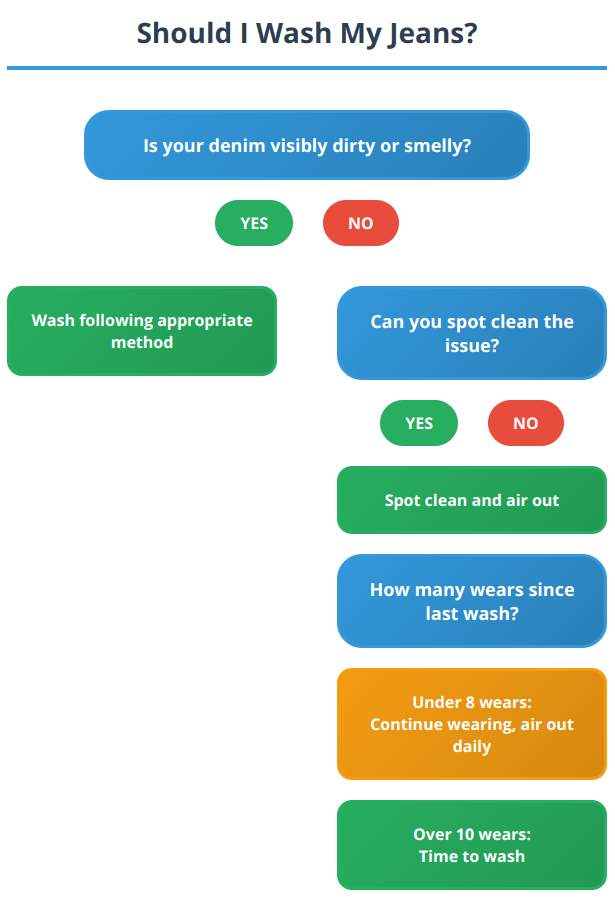
This flowchart takes the guesswork out of denim care decisions. When in doubt, err on the side of less washing rather than more.
For a more comprehensive problem-solving experience, try our detailed troubleshooting flowchart that covers specific solutions for different types of denim issues.
Conclusion
Proper denim care is an investment in both your wardrobe and the environment. By following the principles outlined in this comprehensive guide, you can significantly extend the life of your jeans while maintaining their fit, color, and character. The key takeaways for successful denim care include understanding your specific denim type, washing sparingly with cold water, air drying consistently, and treating each pair with the respect it deserves.
Remember that different types of denim require different approaches. Raw denim needs patience and minimal intervention, while stretch denim requires gentle handling to preserve elasticity. Premium pieces benefit from hand washing and careful storage, while everyday jeans can handle standard machine care with proper technique.
The environmental benefits of proper denim care cannot be overstated. By washing less frequently, using cold water, and air drying, you reduce energy consumption and extend garment life, contributing to a more sustainable fashion cycle. When you consider that proper care can double or triple the lifespan of your jeans, the environmental and economic benefits become clear.
Your denim care routine should evolve with your lifestyle and the changing seasons. Office workers can extend wear between washes, while active individuals may need more frequent cleaning. Summer months might require slightly more frequent washing due to increased perspiration, while winter storage becomes crucial for maintaining fabric integrity.
The investment in quality denim care tools and products pays dividends over time. A good denim-specific detergent, proper hangers, and adequate storage space cost far less than frequently replacing poorly cared-for jeans. When you factor in the time saved from not having to shop for replacements and the satisfaction of wearing perfectly broken-in jeans, the value becomes even more apparent.
Modern washing machines and eco-friendly products make sustainable denim care easier than ever. Take advantage of denim-specific cycles, cold-water detergents, and energy-efficient features to optimize your care routine. However, remember that the most sustainable approach is simply washing less frequently and caring more thoughtfully.
Most importantly, develop a personal relationship with your denim. Each pair tells a story through its fades, creases, and wear patterns. By caring for your jeans properly, you preserve not just the fabric, but the memories and experiences that each pair represents. Whether it’s your favorite weekend pair, professional-appropriate dark wash, or that special raw denim you’re carefully breaking in, each deserves attention and care proportional to its role in your wardrobe.
The journey to perfect denim care is ongoing. Start with the basics – cold water washing, air drying, and proper storage – then gradually incorporate more advanced techniques as you build confidence and experience. Track what works best for your specific jeans and lifestyle, adjusting your approach as needed.
Finally, remember that denim care is not just about preservation; it’s about respect for craftsmanship, sustainability, and the resources that went into creating each pair. When you properly care for your denim, you participate in a more thoughtful approach to fashion that values quality over quantity and longevity over trends. Your future self will thank you for the perfectly aged, well-cared-for jeans that continue to look and feel amazing years down the road.
Ready to put this knowledge into practice? Download our printable denim care chart for your laundry room, or share our ultimate denim care infographic with friends who need better jean care habits.

